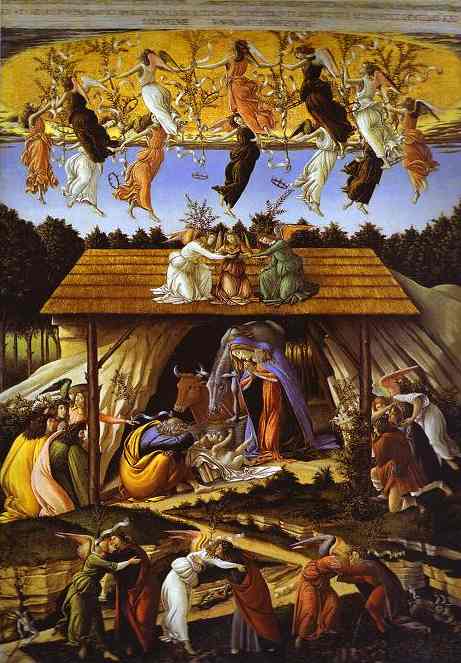The Mystical Nativity by the fifteenth century Florentine artist, Sandro Botticelli, illustrates well the meaning of Christmas. Why is it entitled The Mystical Nativity instead of just The Nativity? “Mystical” here means that the painting has a deeper meaning than at first sight. This was the meaning of the word “mystical” referring in Christian tradition to the deeper meaning of the Bible. But we must give time to contemplation to see the deeper meaning.
At the top there are twelve angels dancing in a circle and heaven, the golden opening in the sky, is above them. The angels are holding olive branches, signs of peace, from which are suspended a crown and a scroll with a prayer written on it. The angels are ascending to heaven with a crown of prayers. Our prayers are carried to heaven by the angels – what a beautiful picture! Isaiah 62:3 says: “You shall be a crown of beauty in the hand of the Lord, and a royal diadem in the hand of your God.” The crown implies that we share the victory brought about by the Messiah’s birth.
At the center of the painting are the Holy Family, who are depicted as much larger figures than the rest to emphasize their importance. Mary adores the infant Christ but Joseph looks like he is asleep. Everything has been too much for poor Joseph, overwhelmed by the events that have come to pass.
There are several aspects of this Nativity scene which point forward to the Cross and Resurrection of Christ. The cave foreshadows the tomb in which Jesus was buried. The cloth on which the baby lies is a reminder of the burial cloth of Jesus. The ass standing behind Mary and the saddle on which Jesus is resting may refer to Christ’s entry into Jerusalem at the beginning of the week leading up to his death. The ass also has a cross on his shoulder. Botticelli here picks up the theme of Matthew and Luke that the birth of the Christ heralds his mission and his death for the sins of the world.
On the right are the shepherds in rustic dress coming to worship Christ on the day of his birth. On the left are the wise men, the magi, whose visit is celebrated on the Epiphany, twelve days later. But notice that they too are in plain dress, nothing fancy, to stress humility and simplicity in the Christian lifestyle.
At the bottom of the painting there are three pairs of angels and men embracing. Going from right to left it seems as though the angels are lifting the men up from a kneeling position to an upright position, as if they were being lifted from the oppression of sin and welcomed into eternal life. There are also seven devils scuttling into cracks in the earth that lead to hell, several of them pierced by their own lances. By coming to earth Christ defeated the power of evil and the oppression of sin. In Galatians 4:7 Paul proclaims that Christians now belong to God – they are children of God adopted into God’s family and joint heirs with Christ in the coming kingdom. We are not slaves to anything but we are children of God! Botticelli has beautifully captured this elevation of human beings in the movement from right to left as the men stand upright and are hugged by the angels. So in this painting we have the gospel of Christ proclaimed in glorious picture language. Peace on earth is proclaimed by the angels, evil is overcome and humankind is reconciled to God and adopted as the children of God.
The artist and poet, William Blake, said this about Christmas: “God became as we are; so that we might become as God is.” The rhythm of Botticelli’s Mystical Nativity is downward and upward. God descends to earth in a baby, the most vulnerable of creatures. God descends to the lowest point of all in the death of his son upon the cross. But then Jesus is raised from the tomb and humans are lifted up and reconciled to God. We are remade in the image of Christ who is true God. We share in the divine destiny. We move with the angels.
What a glorious message! We do not walk alone and we do not walk as those oppressed by evil. We walk free with the angels. We reflect the brightness of Christ. We walk in God’s new world because of Christmas day!
(I am indebted for several of these insights to the catalogue written by Carol Plazzotta which accompanied the exhibition “Kingdom Come” at the National Gallery, London, during the Millennium, 2000 A.D.)


John, thank you for your uplifting post; the images and the words are beautiful, and I’m sure they will stay with me as we get closer to Christmas. I feel there are many entry points into the painting, where I could place myself. It was a great preparation for my morning meditation, too!
This painting was the subject of a special exhibition at the National Gallery in London for the Millenium celebration. That’s where I learned to appreciate its deeper message. Botticelli painted it in the year 1500 A.D., which he called “the half-time after the time”. Thank you, Susan, for your support and friendship on the spiritual journey, and for encouraging me to start blogging.
Thanks for sharing this John!
It certainly is timely.
Blessings on You-Jean and the family.
Shalom,
Carlos
Happy New Year, Carlos, and thanks for introducing me to the Together In Ministry group. I enjoy our conversations on the journey to and from Camp Canonicus.
Pingback: The Meaning of Jesus Is Hidden In Christmas | The Still Point